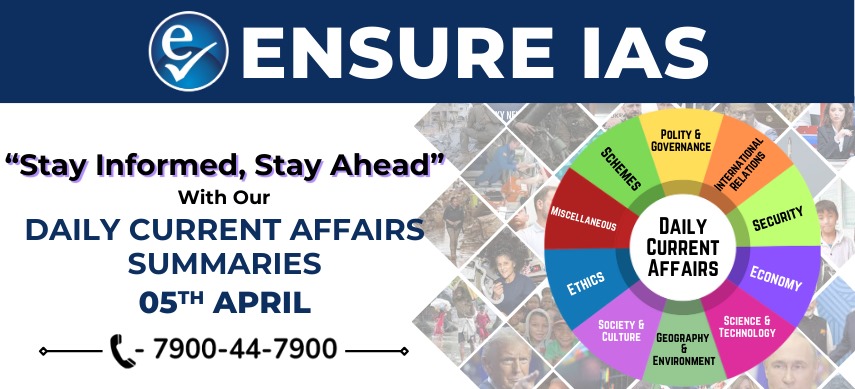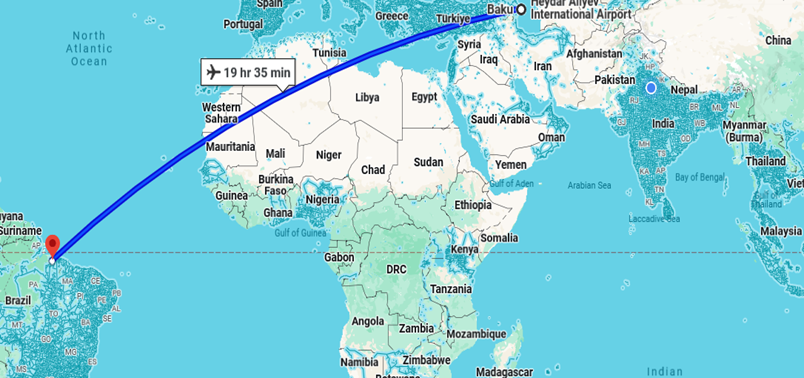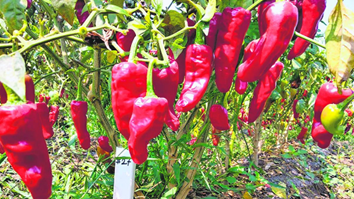- Courses
- GS Full Course 1 Year
- GS Full Course 2 Year
- GS Full Course 3 Year
- GS Full Course Till Selection
- Answer Alpha: Mains 2025 Mentorship
- MEP (Mains Enrichment Programme) Data, Facts
- Essay Target – 150+ Marks
- Online Program
- GS Recorded Course
- Polity
- Geography
- Economy
- Ancient, Medieval and Art & Culture AMAC
- Modern India, Post Independence & World History
- Environment
- Governance
- Science & Technology
- International Relations and Internal Security
- Disaster Management
- Ethics
- NCERT Current Affairs
- Indian Society and Social Issue
- NCERT- Science and Technology
- NCERT - Geography
- NCERT - Ancient History
- NCERT- World History
- NCERT Modern History
- CSAT
- 5 LAYERED ARJUNA Mentorship
- Public Administration Optional
- ABOUT US
- OUR TOPPERS
- TEST SERIES
- FREE STUDY MATERIAL
- VIDEOS
- CONTACT US
Daily Current Affairs Summary 5th APRIL 2025
Daily Current Affairs Summary 5th APRIL 2025

Tigers Outside Tiger Reserves Initiative
- India's tiger population, estimated to be around 3,682, faces significant challenges, especially with nearly 30% of these tigers being reported outside of notified reserves.
- To address this issue, the Ministry of Environment, Forest and Climate Change (MoEFCC) is finalizing the contours of the “Tigers Outside Tiger Reserves” project.
- The initiative aims to monitor the tiger population outside reserves, reduce poaching, minimize human-animal conflict, enhance community outreach, and improve tiger habitats.
- The proposed outlay for the project is Rs 176.45 crore, covering the period until 2026-27.
- The initiative is expected to focus on two primary areas:
- Reducing human-animal conflict
- Stepping up monitoring outside tiger reserves to tackle poaching
Challenges and Human-Wildlife Conflict
- Tigers recorded outside notified reserves are found in forests under the control of territorial and wildlife divisions managed by state forest departments.
- The dispersal of tigers from reserves into forest divisions increases the risk of human-tiger conflict, including livestock depredation and poaching. This also pushes other predators like leopards further towards human settlements, further escalating the risk of human-wildlife conflict.
- Areas such as Wayanad in Kerala, Chandrapur in Maharashtra, and Pilibhit in Uttar Pradesh have been prime examples of recurring human-wildlife conflict.
Implementation Plan
- Based on findings from the 2022 all-India tiger estimation and recent trends in human-tiger conflict, the National Tiger Conservation Authority (NTCA) will implement the project in 80 forest divisions across 10 states.
- To fund the initiative, the ministry has sought support from the National Compensatory Afforestation Fund Management and Planning Authority (CAMPA), which finances wildlife conservation efforts through funds collected from the felling of forests for development projects.
Tiger Population and Conservation
- India is home to an estimated 3,628 tigers (upper limit), spread across 58 tiger reserves. The tiger population is distributed across diverse landscapes, including: Shivalik Hills, Terai Plains, Central Indian Highlands, Eastern Ghats, Western Ghats, Northeastern Hills, Brahmaputra Plains and Sundarbans.
- The Central Indian Highlands and Eastern Ghats host the highest number of tigers, followed by the Western Ghats, Shivalik Hills, and Terai plains.
US President Announces Reciprocal Tariffs
In a significant move, the President of the United States announced reciprocal tariffs on more than 180 countries and economies, introducing a 10% baseline tariff. These new tariffs are designed to address trade imbalances and encourage countries to lower their trade barriers.
Key Details of the Tariff Announcement
- India: The US has imposed a 26% reciprocal tariff on India, which is half the rate that India imposes on US imports.
- Other Major Economies: Similar tariffs were announced for other major economies:
- China: 34%
- Japan: 24%
- European Union: 20%
The reciprocal tariffs aim to counter trade imbalances by imposing higher tariffs on countries with which the US runs a trade deficit.
Reasons Behind the Tariff Announcement
- Reindustrialization: One of the major reasons for imposing these tariffs is to support reindustrialization in the US.
- Retaliation Against Unfair Trade Practices: The tariffs are also a response to perceived unfair trade practices by other countries.
- Economic Nationalism: The move reflects a broader shift towards Economic Nationalism, a trend visible in policies like manufacturing onshoring and the "Make America Wealthy Again" promises.
Economic Nationalism
Economic Nationalism refers to an economic ideology that emphasizes domestic control over the economy, labor, and capital formation. It has two forms:
- Developmentalism: This form uses industrial policy to shape national development goals, similar to India’s planned economic model post-independence.
- Mercantilism/Isolationism: This approach seeks to increase a nation’s prosperity and power through restrictive trade practices, as seen in the "America First" policy of the current US administration.
The reciprocal tariffs are a key element of this shift towards Economic Nationalism, signaling a focus on domestic industry and trade fairness.
Lok Sabha Passes the Coastal Shipping Bill, 2024
The Lok Sabha has passed the Coastal Shipping Bill, 2024, which establishes a dedicated legal framework for regulating coastal trade in India. This includes the regulation of various types of vessels such as ships, boats, sailing vessels, and mobile offshore drilling units.
Key Provisions of the Bill
- License for Coasting Trade:
- The bill removes the requirement for Indian vessels to obtain a trading license, while foreign vessels will still need a license issued by the Director General of Shipping (DGS).
- Coasting trade refers to the transport of goods or passengers by sea between different ports within India.
- Strategic Plan and Database:
- It mandates the formulation of a National Coastal and Inland Shipping Strategic Plan, which will be revised biennially.
- The creation of a National Database for Coastal Shipping is also required.
- Authority to Director General of Shipping (DGS): The DGS will have the authority to seek information, issue directions, and enforce compliance with regulations.
- Central Government Oversight: The bill empowers the Central Government to provide exemptions and regulatory oversight, ensuring efficient and streamlined coastal shipping operations in India.
Significance of the Bill
- Decongestion of Road and Rail Networks: By promoting inland waterways and riverine economies, the bill will help reduce pressure on India’s road and rail networks.
- Reducing Dependence on Foreign Vessels: The development of a coastal fleet owned and operated by Indian entities will decrease reliance on foreign vessels for critical transportation needs.
- Lower Logistics Costs: The bill will contribute to reduced logistics costs, promoting green transport and fostering regional development in coastal areas.
India Urges BRICS to Support 'Baku to Belem Roadmap' for Climate Finance

Baku to Belem Roadmap for Climate Finance
India has called on BRICS nations to unite in support of the 'Baku to Belem Roadmap', a key initiative aimed at mobilizing USD 1.3 trillion in climate finance annually by 2035 to support countries' Nationally Determined Contributions (NDCs) under the Paris Agreement.
|
BRICS member States
|
About the Baku to Belem Roadmap
- The Baku to Belem Roadmap emerged from discussions at the UNFCCC COP29, held in Baku, Azerbaijan.
- It set a new global finance goal and established a framework to raise ambition for climate finance ahead of COP30, which will take place in Belém, Brazil.
- The roadmap's primary objective is to scale up climate finance to support developing countries in adopting low greenhouse gas emissions pathways and building climate-resilient development strategies.
POSHAN Tracker: Enhancing Nutrition Services in India
The Union Ministry of Women and Child Development (MoWCD) has announced that all Anganwadi Centres across India are now registered on the POSHAN Tracker application.
About the POSHAN Tracker
- The POSHAN Tracker is a mobile-based application designed to track attendance, growth monitoring, and nutrition services in real-time.
- The app replaces traditional physical records with auto-generated monthly reports, improving the efficiency and accuracy of data collection.
Key features of the POSHAN Tracker include:
- Available in 24 languages, making it accessible to a wide range of users across India.
- Aimed at enhancing transparency, efficiency, and accountability in the delivery of nutrition services.
Part of Larger Initiatives
The POSHAN Tracker is an integral component of Mission Saksham Anganwadi and POSHAN 2.0, a centrally sponsored scheme that brings together various initiatives:
- Anganwadi Services
- POSHAN Abhiyaan
- Scheme for Adolescent Girls (14-18 years)
These programs work collectively to combat malnutrition across the nation.
The Gift of the Tipitaka to India
During his ongoing visit to India, the Prime Minister of Thailand presented a copy of the Tipitaka in Pali language to the Indian Prime Minister.
About the Tipitaka
The Tipitaka, also known as the Pali Canon, consists of three main collections (or "baskets") of Buddhist texts, which form the foundation of Theravada Buddhism:
- Vinaya Pitaka: Contains rules and regulations for those who join the Sangha (monastic order).
- Sutta Pitaka: Comprises the sermons and teachings of Buddha.
- Abhidhamma Pitaka: Focuses on philosophical matters, offering deep insights into the nature of reality.
Theravada Buddhism
Theravada Buddhism is considered the older tradition of Buddhism. Followers of this tradition, known as Theravadins, respect the teachings and path laid out by the ancient Buddhist teachers, known as the theras.
The presentation of the Tipitaka further strengthens the cultural and spiritual ties between Thailand and India, reflecting the shared heritage of Theravada Buddhism.
India's Seaweed Farming Sector: A Growing Industry
India's seaweed farming sector, currently valued at Rs 200 crore, is poised for significant growth, with projections indicating it will reach Rs 3,277 crore over the next decade. This expansion presents opportunities for both economic growth and health benefits.
About Seaweed
- Seaweed is a nutrient-rich plant that grows in the ocean and seas, containing 54 trace elements and essential nutrients.
- These nutrients are known to have several health benefits, helping to combat diseases such as: Cancer, Diabetes, Arthritis, Heart problems and High blood pressure
Key Products from Seaweed
Seaweed is a versatile resource, providing key products used across various industries:
- Alginate: A natural thickener extracted from brown seaweed, commonly used in food, cosmetics, and medicine.
- Agar: A jelly-like substance derived from red seaweed, widely used in desserts, jams, and laboratory cultures.
- Carrageenan: A gelling agent obtained from red seaweed, frequently utilized in dairy and processed foods.
Pope’s Pit Viper Venom
- A recent study has uncovered critical insights into the venom of Pope’s Pit Viper (Trimeresurus popeiorum), offering valuable information that could aid in the development of antivenom treatments and pharmaceutical advancements.
- This research could be crucial for India’s goal to reduce snakebite mortality by 50% by 2030.
Importance of the Study
- The study of Pope’s Pit Viper venom is significant as it lays the foundation for better understanding venom toxicity, paving the way for the creation of more effective antivenoms and contributing to advances in pharmaceutical research related to snakebites.
- With snakebites being a major health issue in India, this study could play a pivotal role in the ongoing efforts to save lives and reduce fatalities from snakebites.
About Pope’s Pit Viper
- Habitat: The Pope’s Pit Viper is typically found in tropical and sub-tropical wet mountain forests, bamboo forests, mountain scrublands, and swamps.
- Geographic Distribution: This species is native to the northern and northeastern parts of India and is also found in other countries including Myanmar, Thailand, Laos, and Malaysia.
- IUCN Status: Classified as Least Concern by the International Union for Conservation of Nature (IUCN).
NCPOR Commemorates 25th Foundation Day
The National Centre for Polar and Ocean Research (NCPOR) is celebrating its 25th foundation day. Established in 1998, NCPOR is an autonomous research and development institution under the Government of India, located in Goa.
- NCPOR operates under the Ministry of Earth Sciences,
About NCPOR
NCPOR is India’s leading research and development institution responsible for advancing the country’s scientific activities in the polar regions and the Southern Ocean. It plays a pivotal role in India's research efforts in these critical areas.
Key responsibilities of NCPOR include:
- Managing India’s Antarctic research bases: Maitri and Bharati.
- Managing the Indian Arctic base: Himadri.
Record Set in Lok Sabha During Zero Hour
On April 3, a record was set in the Lok Sabha as 202 Members of Parliament (MPs) spoke during a five-hour long Zero Hour.
About Zero Hour
- Zero Hour is a crucial time in the parliamentary proceedings, which occurs immediately after the Question Hour and the laying of papers, but before any listed business is taken up.
- Timing: It begins around 12 noon, which is why it is referred to as Zero Hour.
- Procedure: While it is not formally recognized in the parliamentary procedure, it allows MPs to raise important matters of public interest.
- MPs must submit notices stating the subjects they wish to raise, and the Speaker decides whether to allow the matter to be discussed.
Kumbakonam Betel Leaf and Thovalai Maanikka Maalai Receive Geographical Indication Tags

Two renowned products from Tamil Nadu, Kumbakonam Betel Leaf and Thovalai Maanikka Maalai, have recently been granted the Geographical Indication (GI) tag.
Kumbakonam Betel Leaf
- The Kumbakonam betel leaf is grown in the Cauvery Delta region.
- The specific areas of cultivation include Thiruvaiyaru, Papanasam, Thiruvidaimarudhur, Kumbakonam, and Valaigaman blocks of Thanjavur and Tiruvarur.
- Betel leaves in this region have a rich historical background and have been cultivated for centuries. Along with paddy, other crops like sugarcane and betel vine are traditionally grown in the wetlands of this area.
Thovalai Maanikka Maalai
- The Thovalai Maanikka Maalai is a unique type of garland made exclusively in Thovalai, a small village in the Kanniyakumari district.
- Known for its intricate craftsmanship, the garland features multi-coloured flowers, typically oleander, rose, and occasionally other local flowers, arranged in a distinctive manner that gives the garland its gem-like appearance.
- The artisans of Thovalai have been perfecting this traditional craft for generations, making them the sole custodians of this ancient art form.
- The people of Thovalai are highly skilled in identifying and distinguishing the garlands based on their quality and technique.
Warangal Chapata Chilli Receives Geographical Indication Tag

The Warangal Chapata chilli, also known as Tomato chilli, has been granted Geographical Indication (GI) tag by the GI Registry, Government of India. This is the 18th product from the state of Telangana to receive the coveted GI tag.
Unique Characteristics of Warangal Chapata Chilli
The Warangal Chapata chilli is distinct for its bright red color and round shape, which resembles a tomato, hence its alternative name, Tomato chilli. Despite being less spicy than many other varieties, it is known for imparting a vibrant red color and extensive flavor due to its high content of capsicum oleoresin.
Varieties and Market Impact
The Warangal Chapata chilli has three main fruit types:
- Single patti
- Double patti
- Odalu
|
Also Read |
|
| Public Administration Optional | |
| UPSC Monthly Magazine | Question Answer Practice For UPSC |




